Copiapoa cinerea is a unique globose cactus that is sought after by cactus lovers around the world. Its distinctive ashy coloring, long spines, and woolly crown make this cactus stand out in any cactus collection.
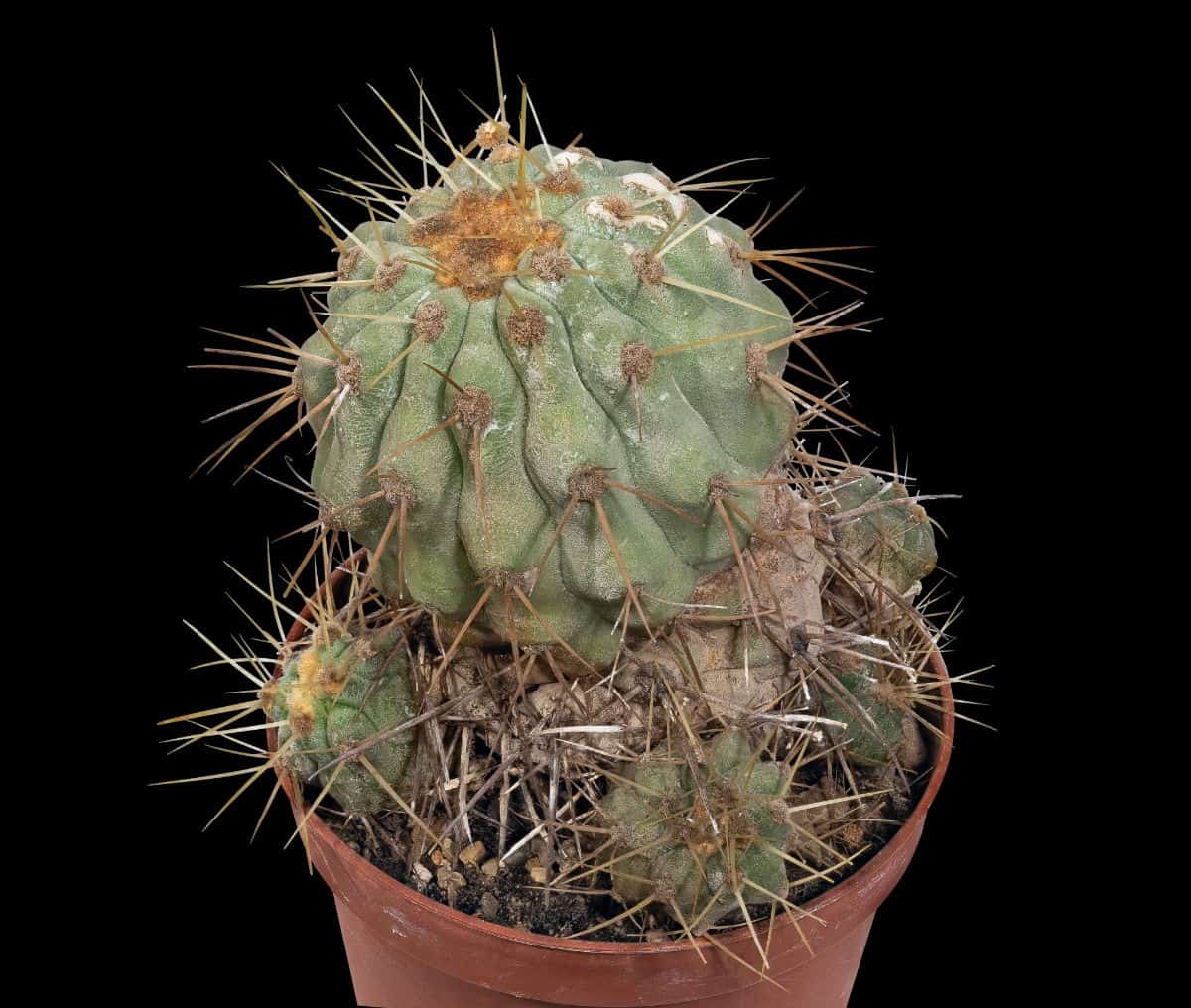
These cacti can be difficult to find, and they can be somewhat difficult to care for as they are prone to rot. However, with the right care, Copiapoa cinerea just might bless your garden with vibrantly colored flowers.
Copiapoa cinerea are native to the Antofagasta region of northern Chile in South America. Their natural habitat is arid, but it’s not uncommon for dense fogs to roll in from the Pacific Ocean, providing the cactus with a source of moisture.
Jump to:
Copiapoa cinerea Appearance
| Name: | Copiapoa Cinerea |
| Soil: | Fast-draining soil |
| Blooming: | Mid spring to early fall |
| Light: | Partial shade or full sun |
| Water: | When the soil is completely dry |
| Propagation: | Offsets and seeds |
Young Copiapoa cinerea are globular in shape, while older specimens tend to be more columnar. At maturity, they typically measure just over 3 feet in height and about 8 inches in diameter. They usually have between 12 and 30 ribs.
Copiapoa cinerea are slow-growing cacti that generally appear as solitary cacti, though older cacti may have offsets near their base.
This species can be recognized by its unique, chalky grey-green color. The coloring is due to a waxy coating that aids the cactus in preventing desiccation in its incredibly dry natural environment. In cultivation, it’s not uncommon for Copiapoa cinerea to lack this coating so they may appear more brown or green than in the wild.
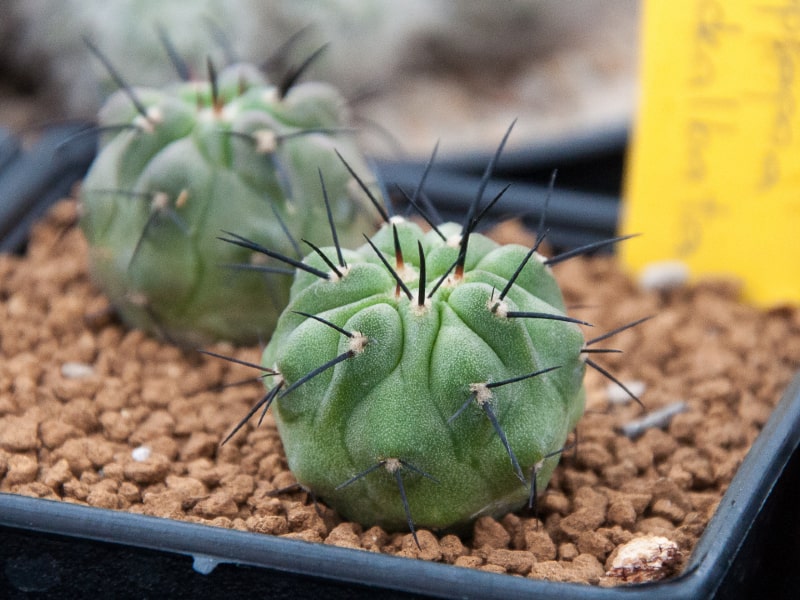
Buy it from:
The spines are sparse and jet black in color. This species varies in spines, as some cultivars may have extremely long spines while others may lack spines entirely. There is often a small patch of wool around the base of the spines as well as at the apex of the cactus.
When in bloom, Copiapoa cinerea produces yellow funnel-shaped flowers that measure about an inch in diameter. Some flowers may also have a reddish or pinkish tint to them. It’s rare for this species to bloom in cultivation, but it is possible.
Cultivars
Since cactus lovers are so fond of this uncommon species, it’s not surprising that several different cultivars have been produced. In addition to varieties produced in cultivation, there are also a few varieties that occur naturally.
Though the cultivars vary in appearance, their care requirements remain the same. Most varieties also reach the same approximate height and diameter at maturity.
Copiapoa cinerea variegata
As you may guess, this cultivar is the variegated form of Copiapoa cinerea. These cacti generally lack the waxy coating of the regular variety, allowing their colors to be more vibrant. Instead of the normal chalky grey, this cultivar is a deep green color with intermittent patches of yellow.
The spines may take on a browner hue than the classic jet black, but in all other aspects, this cultivar is the same as the original variety. The approximate size at maturity and care requirements are the same.
Copeapoa cinerea albispina
This cultivar is also sometimes known as Copiapoa cinerea var. gigantea. This is an extremely unusual cactus that is rarely seen in cultivation. Instead of the jet-black spines of the original variety, this variety has glassy white spines.
No products found.
This version frequently lacks a waxy coating and tends to have a more sensitive epidermis, which often causes the cactus to be covered in cracks and fungal spots.
Copiapoa cinerea longispina alba
This variety of Copiapoa cinerea is known for having long spines. Though this cactus can be seen with white spines, this variety differs from Copiapoa cinerea albispina in that the white spines are typically seen on younger cacti. As the cacti age, the spines frequently darken.
Caring for Copiapoa cinerea
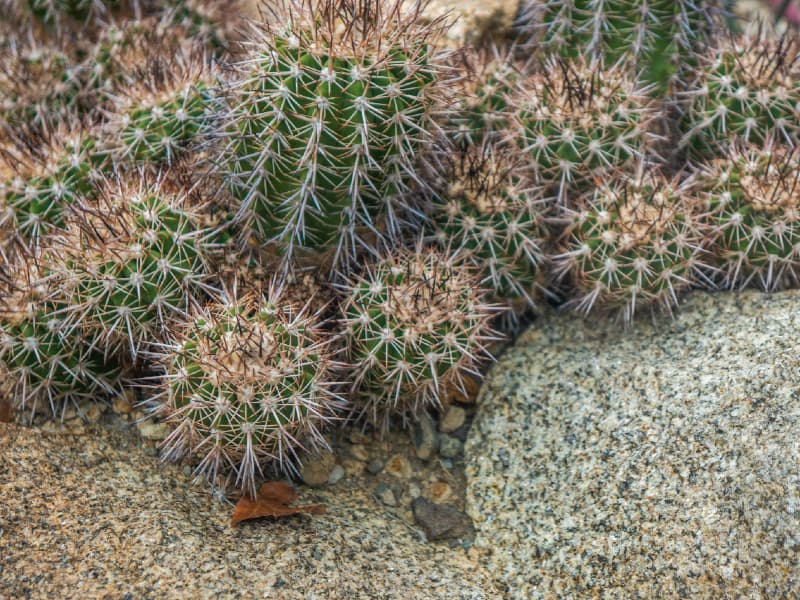
If you’re looking for an easy to care for cactus, Copiapoa cinerea may not be the cactus for you. Though it is a low maintenance plant, this species is known for being somewhat fickle in terms of care requirements.
This species is prone to rot, so it’s crucial to keep a close eye on moisture levels to prevent accidental overwatering. Remember, when it comes to cacti, it’s generally best to err on the side of dryness.
Light
Copiapoa cinerea generally prefer partial shade or full sun. In particularly hot climates, such as the southwestern United States, it may be best to plant this cactus in partial shade to protect it from direct sun during the hottest part of the day.
Though these cacti do enjoy plenty of light, they may be sunburned if placed in areas with too much direct sunlight, especially if they’ve previously been kept indoors. Individual cacti that do not have a protective layer of farina on their epidermis will be more prone to sunburn than those with that extra layer of protection.
Whenever you increase the amount of direct sunlight your cactus receives, be sure to do so slowly over a period of several weeks to allow the plant time to adapt. Increasing light too quickly will result in sunburn.
If you begin to notice patches of discoloration on your cactus on areas exposed to the sun, you need to reduce the amount of sunlight immediately. Sunburn damage is usually cosmetic, but prolonged periods in too much light can be fatal.
Damage caused by sunburn cannot be repaired, so if your C. cinerea gets burned, you’ll just need to accept its new appearance. Unfortunately, since this cactus does not have branches, it’s not possible to trim away the damaged areas as you would with other species.
It’s important to make sure your cactus isn’t getting too much light, but you’ll also need to make sure it’s getting enough light. This is not an ideal plant for low light environments so if your indoor space does not provide enough light, you’ll need to invest in a grow light.
Without adequate light, your Copiapoa is likely to become misshapen as it grows in search of a better light source. It will not thrive without adequate light and its growth will be poor.
Water
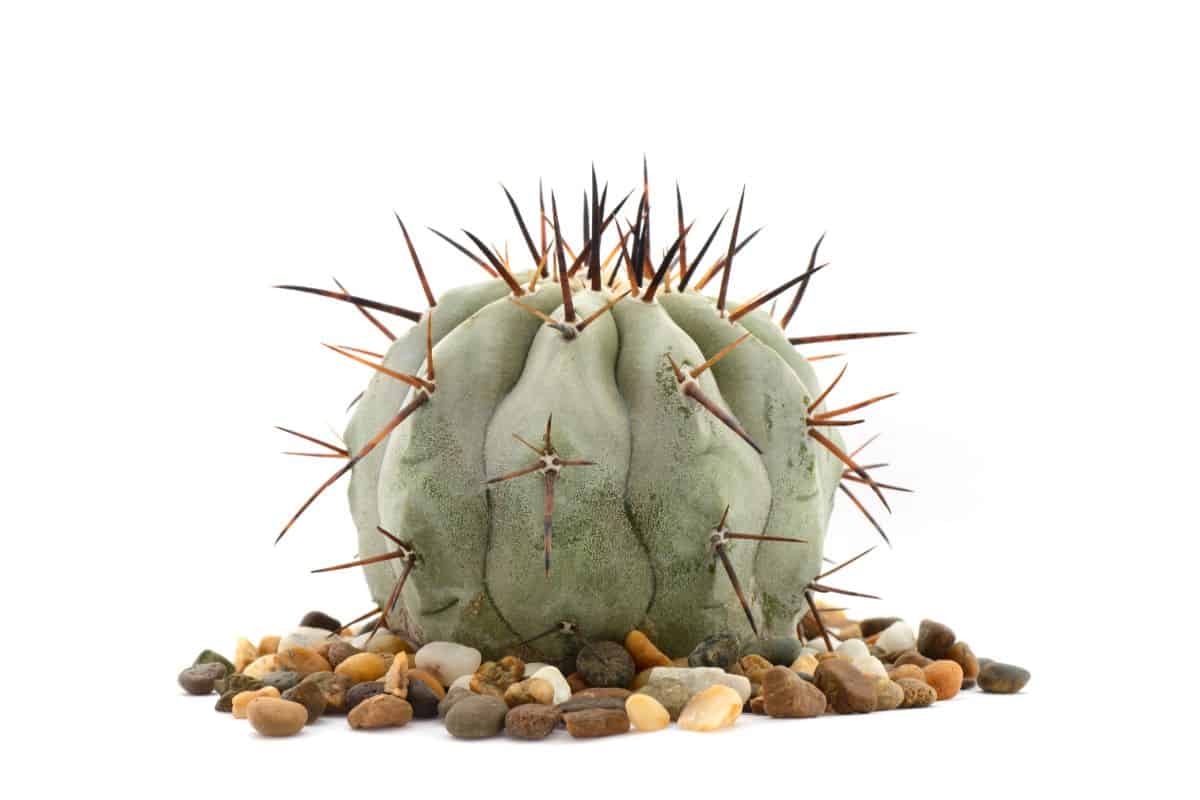
As with most species of cacti, it’s important to let the soil dry out between watering to ensure that you don’t accidentally overwater your Copiapoa cinerea. Overwatering is the most common problem gardeners have with species.
These cacti are prone to rot, so your watering schedule must be precise. If there is any moisture in the soil, you need to avoid watering the cactus until the soil is completely dry.
This means you’ll need to check the soil regularly using a soil moisture meter or your finger. Simply insert the tool of your choice into the soil. If the soil is anything but bone dry, you’ll need to wait a few days before checking again.
You may also need to adjust your watering schedule based on the weather. Humid, wet weather will not allow for fast evaporation so you may need to reduce the frequency of watering.
However, Copiapoa cinerea is a species that typically goes dormant during the summer months, so you’ll be able to stop watering entirely during this time. With particularly hot climates, you might consider misting the cactus in the early mornings to simulate its natural environment and provide the cactus with some moisture.
Temperature
C.cinerea is not a frost-tolerant species of cactus. If temperatures drop below about 30 degrees Fahrenheit, you’ll need to bring your cactus indoors to prevent frost damage. Remember, these cacti are used to the relatively warm temperatures of northern Chile.
It’s important to note that these cacti will be better able to handle cool temperatures when dry, so it’s essential to keep the soil on the dry side until the weather warms up a bit.
These cacti can handle extreme heat so long as it’s not combined with direct sunlight. Hot weather and direct sunlight will result in sunburn and can be fatal if not addressed as soon as possible.
As previously mentioned, during periods of extremely hot weather, you may consider misting Copiapoa to help keep the plant hydrated without the risk of overwatering.
Read Related Article: Sansevieria Pinguicula
Soil
Copiapoa cinerea require fast-draining soil. Its natural habitat is sandy and rocky with little organic material, so you’ll need to imitate this if you want your cactus to thrive.
Avoid any soil mix that contains ingredients that retain water such as clay, peat moss, and coconut coir. These materials will cause the roots to sit in moist soil for too long and will certainly lead to root rot.
Instead, look for a mineral-based substrate with little organic material. Commercial cactus soil can be a great place to start, but it will need to be altered by adding large particles of substrate such as coarse sand, gravel, or perlite.
Most experienced gardeners recommend planting Copiapoa cinerea in a gritty mix formulated for use with cacti and succulents. Gritty mixes typically retain little moisture and promote the proper drainage and airflow required by these fickle cacti.
As for fertilizing, most gardeners choose to skip this step entirely or fertilize lightly on occasion. Despite the lack of nutrients in their mineral-based substrate, this is not a cactus that requires feeding on a regular basis.
Container
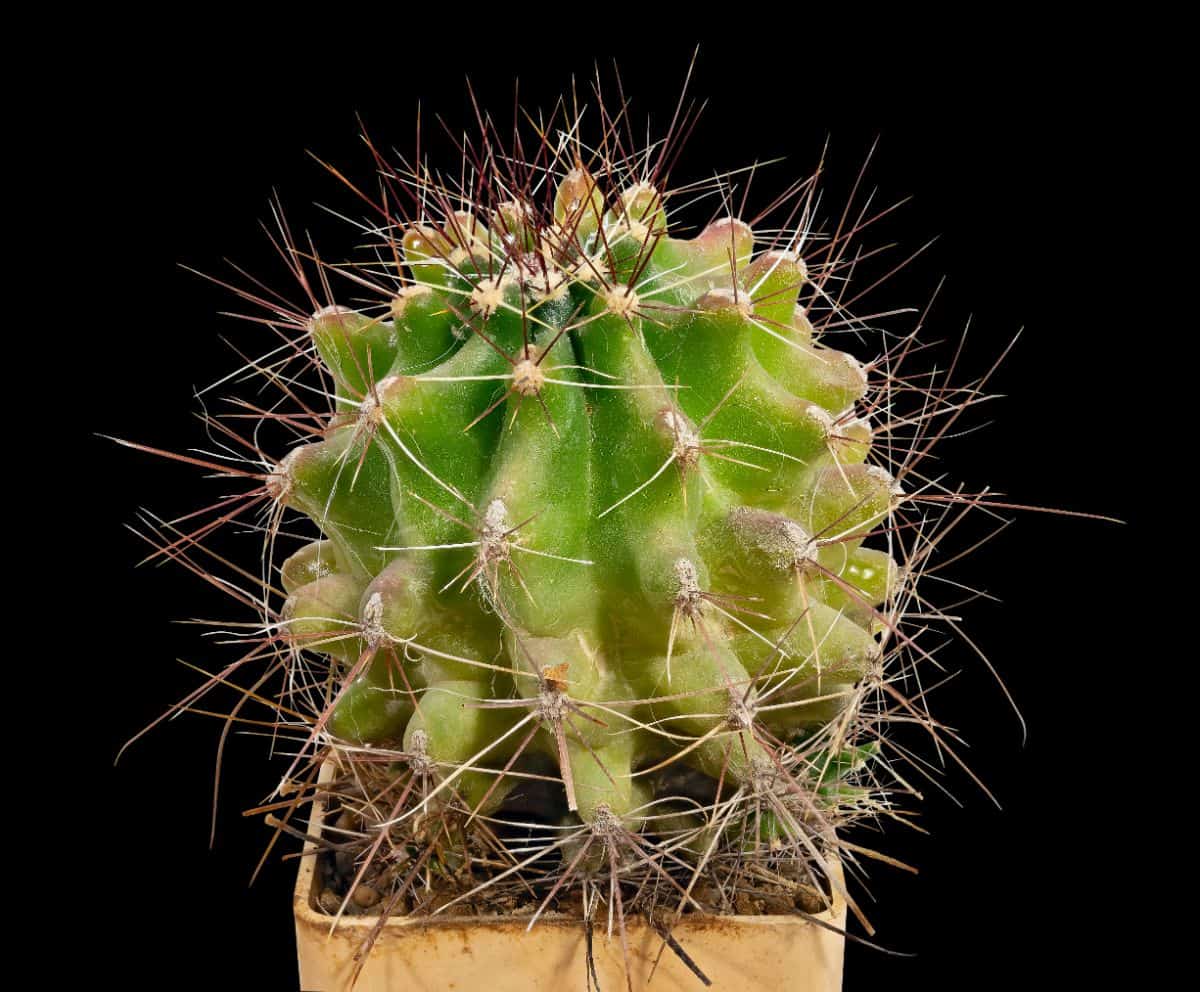
After choosing a fast-draining soil, you’ll need to make sure your pot allows excess moisture to drain away from your Copiapoa cinerea. These cacti are extremely prone to rot, so you’ll need to save that quirky pot without a drainage hole for another plant.
The material your container of choice is made of will also have an impact on drainage. Terracotta pots tend to absorb excess moisture from the soil, allowing it to dry out more quickly.
Plastic or glazed ceramic pots do not absorb water, so the excess moisture will only be able to leave the pot through the drainage holes on the bottom as well as from the top through evaporation.
If you’re prone to overwatering, you may want to go with a terracotta pot as it will be the most forgiving in terms of drainage.
It’s a common misconception that lining the bottom of your pot with rocks or gravel will increase drainage, but unfortunately, this is simply not true.
Due to the unique properties of water, the rocks do not improve drainage and instead create a perched water table. This raises the water table within the pot, putting it closer to the roots of your Copiapoa instead of encouraging it to drain out the bottom of the container.
You’ll also want to make sure the pot you choose for your cactus is an appropriate size. Pots that are too large will retain too much moisture, putting the cactus at risk of rotting.
Pots that are too small will dry out too quickly and could potentially cause the plant to become rootbound, which will inhibit the absorption of water and nutrients.
Rather than choosing the roomiest pot you have, choose one that is just an inch or two larger in diameter than the root ball itself. And when you repot your Copiapoa cinerea, choose a pot that’s just an inch or two larger in diameter than the previous one.
Propagating Copiapoa cinerea
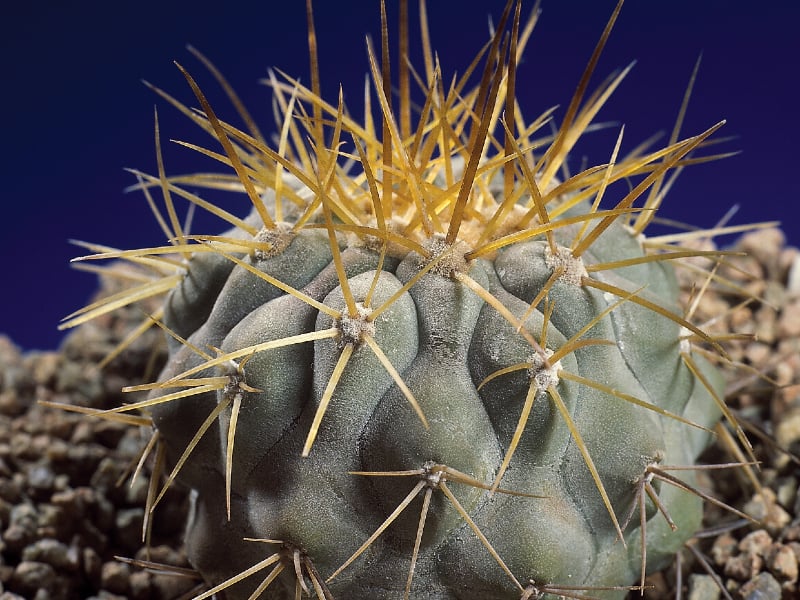
Copiapoa cinerea can be a challenge to grow for even experienced gardeners. However, if you’ve been successful in caring for your cactus, you may want to consider propagating it. Propagation is a great way to add more cacti to your collection or share your hobby with family and friends.
Though many species of cacti can be easily propagated with cuttings, Copiapoa cinerea is not one of them. If you’re interested in propagating your Copiapoa, it’s best to separate any offsets that may be growing around the base of the cactus or try to grow them from seeds.
Check Also: Agave Isthmensis
Offsets
Separating offsets is by far the easiest method of Copiapoa propagation. The offsets are basically tiny versions of a mature plant, so they require little effort on your part beyond basic care.
These cacti are incredibly slow-growing, so it can take quite a long time until they’re ready to spend their energy reproducing. Your C. cinerea will likely not produce offsets on a regular basis unless you’re able to provide it with its ideal environment.
To separate offsets, you can simply grab the offset near its base and gently pull it away from the mother plant. Brushing away the top layer of soil can be helpful as well. You may also divide the roots using a sharp, clean knife.
When handling Copiapoa cinerea, it’s important to handle the cacti carefully, both for your safety and the cactus. Their spines can be sharp, so you may need to wear protective gloves or use tools to gently grasp the offsets.
Some gardeners use tools such as chopsticks, towels, or newspaper to safely handle cacti. However, it’s important to grab the cacti gently as a strong grip can cause the spines to penetrate your gloves, towel, or newspaper. Rough handling can also damage the cactus.
Once you’ve separated the offset, it’s recommended to allow it to callous over a period of a few days. This will allow any wounds to seal, preventing potential infection by fungus or bacteria.
After the wounds have calloused, your new offset is ready to be planted in Copiapoa approved soil. At this point, caring for the offset is as simple as caring for a mature plant.
Seeds
The second method of Copiapoa cinerea propagation is with seeds. C. cinerea seeds can be harvested from your existing plants after blooming and pollination or you can buy them from a reputable seed vendor.
There are plenty of great places online to find succulent and cactus seeds, but since this is a relatively rare plant, it can take some searching to find the right vendor.
It’s worth noting that propagating Copiapoa by seed is a slow and difficult process and success is not guaranteed. Seeds must be planted shortly after collection to ensure the highest chance of success.
As this is an incredibly slow-growing cactus, seed development will also be very slow. This is definitely not a project for an impatient cactus lover.
If you’re up for the challenge and have been able to locate seeds, you’re ready for sowing. Seeds should be planted in late spring or summer when the weather is dry.
Sprinkle your seeds in a container or seed tray filled with fast-draining soil. Moisten the soil and spread the seeds across the surface. You can add a thin layer of substrate on top of the seeds, but this isn’t necessary.
Cover the seeds with a glass or plastic sheet to help retain moisture. The container should be placed in an area with bright, indirect light. The ideal temperature for germination is about 70 degrees Fahrenheit.
Once the seedlings appear at the surface of the soil, you can remove the glass or plastic cover and allow the soil to dry out a bit more.
At this point, you can begin treating the seedlings more like you would a mature plant. However, it’s best not to repot them until they’re big enough to handle without accidental damage.
Copiapoa grow slowly, so your seedlings may not need repotting for quite some time.


